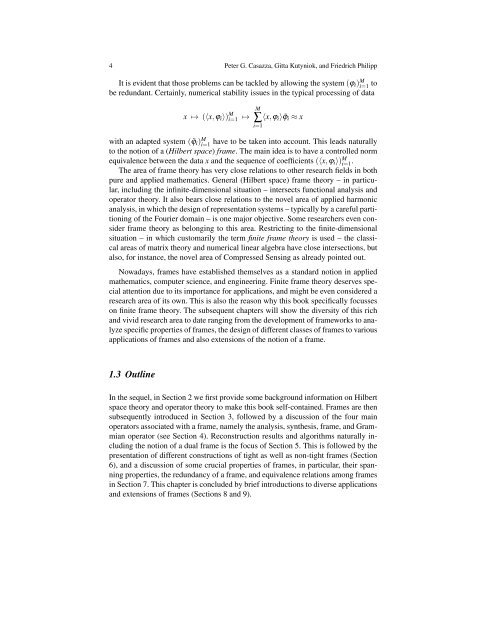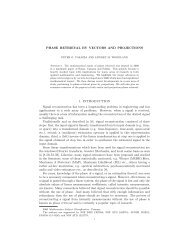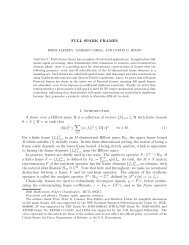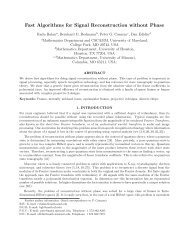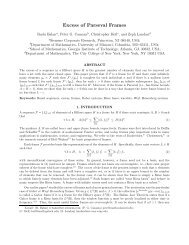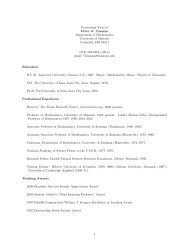Introduction to Finite Frame Theory - Frame Research Center
Introduction to Finite Frame Theory - Frame Research Center
Introduction to Finite Frame Theory - Frame Research Center
Create successful ePaper yourself
Turn your PDF publications into a flip-book with our unique Google optimized e-Paper software.
4 Peter G. Casazza, Gitta Kutyniok, and Friedrich Philipp<br />
It is evident that those problems can be tackled by allowing the system (ϕ i ) M i=1 <strong>to</strong><br />
be redundant. Certainly, numerical stability issues in the typical processing of data<br />
x ↦→ (〈x,ϕ i 〉) M i=1 ↦→<br />
M<br />
∑<br />
i=1<br />
〈x,ϕ i 〉 ˜ϕ i ≈ x<br />
with an adapted system ( ˜ϕ i ) M i=1 have <strong>to</strong> be taken in<strong>to</strong> account. This leads naturally<br />
<strong>to</strong> the notion of a (Hilbert space) frame. The main idea is <strong>to</strong> have a controlled norm<br />
equivalence between the data x and the sequence of coefficients (〈x,ϕ i 〉) M i=1 .<br />
The area of frame theory has very close relations <strong>to</strong> other research fields in both<br />
pure and applied mathematics. General (Hilbert space) frame theory – in particular,<br />
including the infinite-dimensional situation – intersects functional analysis and<br />
opera<strong>to</strong>r theory. It also bears close relations <strong>to</strong> the novel area of applied harmonic<br />
analysis, in which the design of representation systems – typically by a careful partitioning<br />
of the Fourier domain – is one major objective. Some researchers even consider<br />
frame theory as belonging <strong>to</strong> this area. Restricting <strong>to</strong> the finite-dimensional<br />
situation – in which cus<strong>to</strong>marily the term finite frame theory is used – the classical<br />
areas of matrix theory and numerical linear algebra have close intersections, but<br />
also, for instance, the novel area of Compressed Sensing as already pointed out.<br />
Nowadays, frames have established themselves as a standard notion in applied<br />
mathematics, computer science, and engineering. <strong>Finite</strong> frame theory deserves special<br />
attention due <strong>to</strong> its importance for applications, and might be even considered a<br />
research area of its own. This is also the reason why this book specifically focusses<br />
on finite frame theory. The subsequent chapters will show the diversity of this rich<br />
and vivid research area <strong>to</strong> date ranging from the development of frameworks <strong>to</strong> analyze<br />
specific properties of frames, the design of different classes of frames <strong>to</strong> various<br />
applications of frames and also extensions of the notion of a frame.<br />
1.3 Outline<br />
In the sequel, in Section 2 we first provide some background information on Hilbert<br />
space theory and opera<strong>to</strong>r theory <strong>to</strong> make this book self-contained. <strong>Frame</strong>s are then<br />
subsequently introduced in Section 3, followed by a discussion of the four main<br />
opera<strong>to</strong>rs associated with a frame, namely the analysis, synthesis, frame, and Grammian<br />
opera<strong>to</strong>r (see Section 4). Reconstruction results and algorithms naturally including<br />
the notion of a dual frame is the focus of Section 5. This is followed by the<br />
presentation of different constructions of tight as well as non-tight frames (Section<br />
6), and a discussion of some crucial properties of frames, in particular, their spanning<br />
properties, the redundancy of a frame, and equivalence relations among frames<br />
in Section 7. This chapter is concluded by brief introductions <strong>to</strong> diverse applications<br />
and extensions of frames (Sections 8 and 9).


